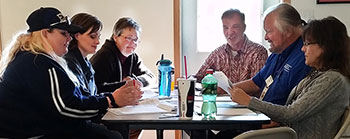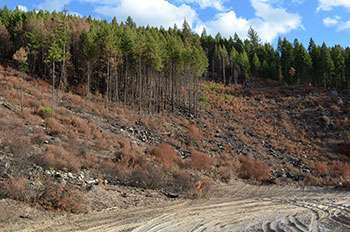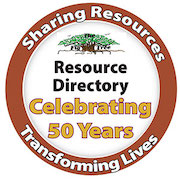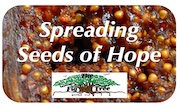Wildfire recovery in region to be done by VOAD groups
Once the initial disaster responders leave, Volunteer Organizations Active in Disasters (VOADs) provide communication and cooperation among faith-based, government and tribal agencies and other volunteer groups for long-term recovery.
 |
|---|
| From the right, Janeane Leachman of New Hope Center and Mike Bullard of INVOAD train group to be disaster resource specialists. |
Mike Bullard, chair of the Inland Northwest Voluntary Organizations Active in Disasters (INVOAD) recently told of recovery efforts since summer wildfires in Washington and Idaho.
INVOAD is focusing on Stevens County—especially around Colville—and in Central Idaho.
It also communicates with Washington VOAD (WAVOAD), which is arranging long-term recovery in Central Washington, including Okanagan County.
“They had a bigger situation, and link with groups in Seattle,” he said. “Including last year, 400 homes were destroyed by wildfires. Many were uninsured. They need to find and train people to interview survivors and match them with appropriate resources.
The primary focus of the Red Cross is immediate relief, but they also work with the VOADs on long-term connections, said Mike who has served the church through disaster relief since he retired in 2009 after 16 years as pastor of First Presbyterian Church in Coeur d’Alene.
In Stevens County, 18 homes were destroyed. Mike went there to form a long-term recovery organization. He told what other communities have done, suggested a shape for their organization and gave ideas for bylaws.
Their goal is to create long-term recovery that brings together resources from as many different sources as possible to put people back into their homes, Mike said.
Idaho VOAD (IDVOAD) set up a multiple agency resource center where all the resource groups have a table, so victims can sign up for everything in one place.
INVOAD’s biggest job is in Central Idaho, where 60 homes were destroyed. It is working there with IDVOAD. Most are in remote areas where no insurance is available. Low-income homeowners could not afford insurance. Some live in house trailers.
 |
|---|
| Burned hillside in Springdale, WA. |
Mike said there are special resources for five tribal homes, but not for others who lost everything.
The primary focus is on Kamiah. The town was saved, but wildfires came within two miles.
“There are countless places where animals survived,” Mike said, “but owners lost a pump house and crops to feed them, or fences to contain them.”
Mike gave history on VOADs.
Originally, many independent federal agencies worked separately on disaster relief. President Jimmy Carter brought them together under the Federal Emergency Management Administration (FEMA). President George W. Bush brought FEMA under Homeland Security. FEMA can be a major funding resource in some declared disasters.
About 100 national partners work in the national VOAD. They include many Christian denominations and other faith groups. Each state has a VOAD.
FEMA works in the background, providing educational materials on disaster preparedness. It helps with planning and training, Mike said.
INVOAD works across the state line, relating to WAVOAD and IDVOAD to use resources closer than either state capitol.
The United Methodist Committee on Relief will train disaster case managers in both states from Oct. 13 to 15, at the Spokane Valley United Methodist Church, 115 N. Raymond. They learn to work with families to access resources.
A long-term Wildfire the Unmet Needs Committee serving Clearwater, Idaho and Lewis Counties is receiving resources from the Unmet Needs Committee in Canada.
Presbyterian Disaster Assistance will hire two part time staff. Other staff will be hired by others.
For groups or individuals who want to be involved in disaster relief, Mike advises joining a VOAD before a disaster strikes.
He gave examples of some groups that work together:
• Presbyterian Disaster Assistance is helping because there are many Presbyterian churches in the Kamiah area.
• Seventh Day Adventists manage supplies and materials.
• Southern Baptists bring and serve hot food in kitchen trucks.
• Samaritan’s Purse sends heavy equipment when needed.
• Mennonites and Amish send builders.
• Presbyterians offer emotional and spiritual care. They also help with long-term recovery and hospitality sites for volunteers.
• United Methodists, Catholic Charities and the Salvation Army have expertise in case-by-case management of resources.
• Presbyterian Disaster Assistance has a national call center to match work groups, skills and projects. Building projects begin in the spring of 2016.
Next summer Mike expects to see individuals and teams from various churches working together on re-building homes.
“We need to understand disasters as a part of life,” Mike said. “It is reality because of population density, climate change, human-caused disasters, and technological and industrial hazards such as plane crashes, train derailments, chemical explosions and crude oil shipments. There also will be natural disasters, such as hurricanes and and earthquakes.”
He urges people to send items or money to organizations set up to disperse them as necessary.
He recommends the Red Cross, Stevens County Disaster Relief and Recovery at PO Box 289, Colville 99114, and the IDVOAD at PO Box 16761 in Boise 83705 for Kamiah.
For information, call (208) 659-2491 or mabullard@gmail.com.
Copyright © October 2015 - The Fig Tree






